🙅 1. Don’t judge, shame, or complain: Criticizing people doesn’t work—it just makes the other person defensive and resentful. Instead, lead with understanding and empathy.
Let me tell you something most people never figure out:
Criticizing someone doesn’t make them change. It just makes them hate you.
Sounds harsh? Good. Because this one mistake ruins more relationships, businesses, and opportunities than almost anything else.
Avoid direct criticism
The young Dale Carnegie used to argue all the time. He was smart and clever. Loved to win debates and tear apart other people’s arguments. But after a while, he noticed something strange…
He won the argument—but lost the relationship. Because people didn’t walk away thinking, “Wow, he’s right.” They walked away thinking, “What a jerk.”
Over time, Carnegie learned that arguing was useless. Even if you manage to prove your point, the resulting resentment can damage the relationship forever. This led Carnegie to adopt a golden rule: always avoid direct criticism or disapproval.
Who was Dale Carnegie, anyway?
Dale Carnegie grew up on a farm in Missouri, spending his early days herding cattle and picking strawberries. After college, he struggled a bit before landing a job selling soap, bacon, and lard—where he became one of the top salesmen in his region.
Later, he started teaching public speaking at the YMCA, and his classes exploded in popularity. His big idea? Get everyone talking, every time—so they’d build confidence and finally shake their fear of public speaking. That simple shift turned into a nationwide movement.
Carnegie went on to write How to Win Friends and Influence People, which has helped millions of people—from shy students to Fortune 500 executives—learn how to communicate better, deal with difficult people, and become more persuasive in everyday life. His work is still just as useful today as it was nearly a century ago.
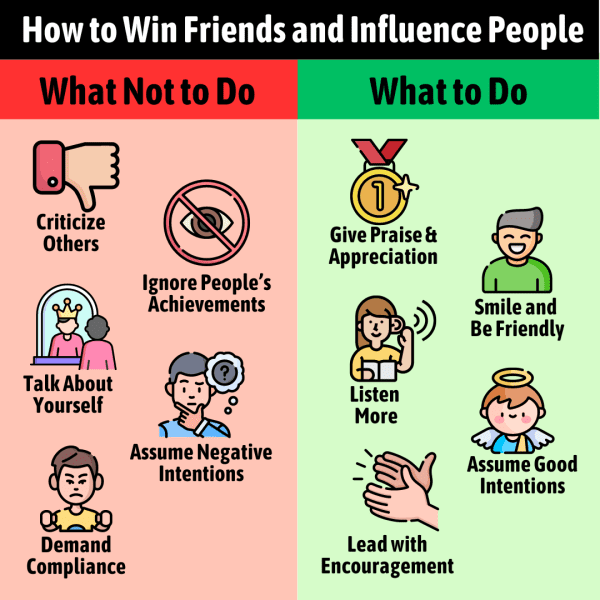
Why doesn’t criticism work?
Many people think that calling someone out is going to help them change for the better. But in reality, this never happens.
Al Capone was the most infamous gangster in history. He was involved in countless bloody gun fights and murders. But after all that, he still didn’t see himself as the bad guy. He thought he was just a misunderstood nice guy trying to help people enjoy life.
The warden of a large New York prison says that almost all criminals are like that. They don’t think they are bad, but always convince themselves whatever they did was justified. If even the worst criminals don’t blame themselves for anything, imagine how easy it is for regular people to do the same!
When people are attacked, their natural instinct is to defend themselves, even if they are wrong. Instead of reflecting on your criticism, they will immediately counter-attack you. It’s almost an involuntary reaction.
People aren’t walking robots driven by logic and facts. They’re emotional, driven by pride and biases. That’s why shaming almost never causes change—it just triggers a fight-or-flight response.
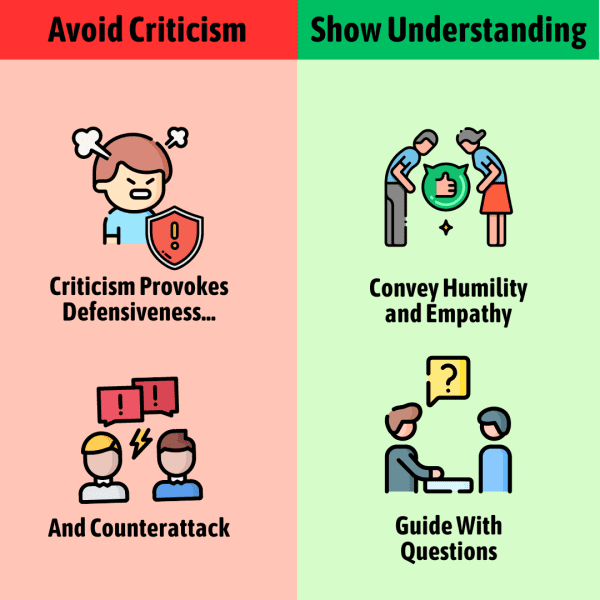
What to do instead?
The young Abraham Lincoln loved to criticize others, even ridicule them.
Then in 1842, he wrote a brutal anonymous letter attacking a political rival that was published in the newspaper. The guy found out who wrote it—and challenged him to a duel. Yes, a real one. With guns.
It almost killed him.
After that, Lincoln changed. He still disagreed with people—but he learned to do it with humility and understanding.
He learned: if you want to influence someone, don’t attack them. Disagree gently. Show respect. Act like an adult. He tried to understand where people are coming from. Even when he disagreed.
That shift made him a better leader and helped him guide a divided country through the American Civil War. For example, when General Meade missed a golden opportunity to end the war, Lincoln tried to understand his point of view, rather than automatically criticizing. The General was actually in the battlefield, surrounded by thousands of weary, injured men.
(Later in this book we’ll learn more about how to provide feedback without offending others by guiding people with questions and leading with humility.)
- Stop judging, shaming, or criticizing people. It almost always backfires. Because criticism feels like a punch in the face—even when you’re right.
- People are emotional, not logical. They will resent you and counter-attack.
- If you want real change, skip the shame. Start with empathy. Try to understand why they do what they do.
The 7 Habits of Highly Effective People by Stephen Covey is a classic personal development book that continues to be incredibly popular. One of the seven key principles it shares is “Seek first to understand, then to be understood.”
Covey believed that “Most people do not listen with the intent to understand; they listen with the intent to reply.” In other words, most people fail to truly listen because their minds are already busy thinking of what they will say next.
To become an effective communicator, you must start by truly listening. Truly listening makes people feel understood. And when they feel understood, they open up to hearing what you have to share.
🙌 2. Give Sincere Appreciation: Everyone wants to feel important. When you honestly praise others, they naturally like you more.
Here’s the secret to making anyone like you:
Make them feel important.
Most people are starving—not for food or money, but for recognition. They just want someone to notice that they matter. That they’re doing okay. That they’re not invisible.
This is true for everyone, from the wealthiest CEO to the teenage gang member. They’re all looking for that feeling of importance.
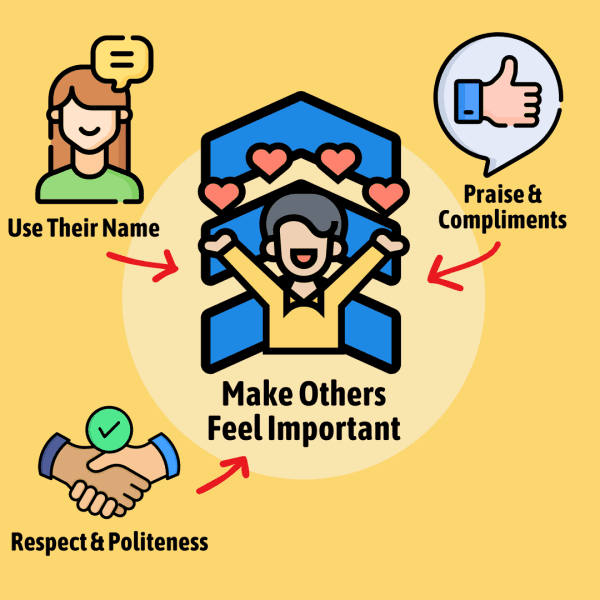
Dale Carnegie didn’t tiptoe around this idea. He used the exact phrase “a feeling of importance” 28 times in the book. That’s how much it matters.
Because when you make someone feel seen—even a little—they light up.
But if you make them feel small or ignored? They’ll dislike you without even knowing why.
Great leaders appreciate, not criticize
Charles Schwab was the highest-paid business leader of his time, the president of a major steel company.
His secret? Not working 20-hour days. Not being the smartest in the room.
Schwab’s greatest asset was being able to inspire enthusiasm through sincere appreciation. He avoided criticism and was quick to praise what people were doing right.
And the result? People loved working for him. They gave him their best effort.
Look for the good
It’s easy to notice what people are doing wrong. But the real skill?
Notice what they are doing right—then mention it out loud.
Carnegie says to give honest, specific compliments.
Don’t fake it. Don’t give empty flattery that you don’t really mean.
Actually notice something good in someone and tell them. That tiny moment can make their whole day—and change how they see you.
- People want to feel important—give that gift.
- Offer sincere, specific praise when you notice something good.
In the super-bestselling book “The 48 Laws of Power” by Robert Greene, law number one is “Never outshine the master.” He says it is “perhaps the worst mistake of all” when we are seeking influence.
Why is “outshining the master” such a big mistake? Because when you make yourself look better than someone else, especially a superior, that makes them feel unimportant. They may even feel threatened and try to take you down.
For example, a top minister for King Louis XIV threw an extremely extravagant party in honor of the king, filled with the finest foods, music, and luxuries. But instead of feeling honored, the King felt threatened and threw the minister into jail on vague charges of corruption.
That’s why it’s better to let your boss get more of the credit and glory, while you quietly accumulate power.
This next rule might sound obvious, but most people get it completely backwards.
🎯 3. Speak To What They Want: To influence anyone, stop focusing on what you care about. Talk about what they want and how to get it.
When you want something—a sale, a job, a “yes,” a little cooperation—you probably start talking about you.
What you need. What you think. Why your thing is so great.
But that’s the fastest way to make someone lose interest.
The harsh truth is nobody cares what you want.
They’re too busy thinking about themselves. Their problems. Their goals. Their fears. That’s not selfish—it’s just human.
You want influence? Figure out what they want right now—and show them how to get it.
As the classic sales trainer Zig Ziglar said, “You can have everything in life you want if you will just help enough other people get what they want.”
Read our summary of Secrets of Closing the Sale by Zig Ziglar
This is how you sell without “selling”
Forget “tactics.” Forget “tricks.”
Always begin with focusing on their problems, challenges, and desired outcome. Then show them how your product or service will help them get there.
Here’s a great example: A woman named Mrs. Anderson wanted a job in banking. She sent letters to 12 different banks, but instead of saying the usual, “I want this job,” she said: “Here’s how I can help your bank make more money.”
Eleven banks wrote back. She got what she wanted—because she focused on what they wanted.
Another example: Dale Carnegie once hosted events in a hotel ballroom. One day, the manager tried to raise the rent by 300%, Carnegie didn’t argue or get angry.
He calmly made a list of advantages and disadvantages of raising the rent. He showed how his events brought educated, high-income guests to the hotel—essentially free advertising.
The result? The rent increase dropped from 300% to just 50%. Why? Because Carnegie framed the issue in terms of the hotel’s interests, not his own.
Ask: What do they want?
Most people waste too much time trying to “convince” other people to do what they want. They don’t know there’s a much better way.
- Instead of asking, “How do I make them do what I want?”
- Start asking, “What do they want—and how can I help them get it?”
For example, one dad was trying to get his son to eat more—but nothing worked. So he stopped asking, “How do I get him to eat?” and he asked, “What does my son want?”
He knew the kid wanted to be strong enough to stand up to the neighbourhood bully. So the dad said: “Eating more will help you get bigger and stronger.”
The kid cleared his plate every time after that.
- Most of us focus too much on what we want. But people care about themselves—not you.
- To influence people, ask “what do they want?” then help them get it.
🐶 4. Be Genuinely Interested: To make friends, stop trying to impress people, and instead be curious about them
Let me ask you something: Why do people love dogs so much?
It’s not because they’re smart.
It’s not because they’ve got great conversation skills.
It’s because dogs greet us like we’re the best part of their day. They wag their tails, jump around, and act like seeing you is the highlight of their life.
That enthusiasm makes us feel good. It’s sincere, it’s warm—and it’s contagious.
Now imagine treating people with that same kind of genuine interest (without the tail wagging, obviously).

The secret to making friends
Most people try to impress others. They talk about themselves. They try way too hard to be interesting.
But here’s what Dale Carnegie figured out:
“You can make more friends in two months by being interested in them than in two years by trying to get them interested in you.”
Or more simply: If you want to be interesting—be interested.
Ask questions.
Listen.
Care.
Stop trying to be impressive. Start being curious. That’s how real connection starts.
Talk about what interests the other person
If you want to be seen as interesting, stop talking about yourself. Find out what they care about.
Dale Carnegie once sat next to a botanist at a dinner party. Now, he doesn’t care about plants. But he got curious, leaned in, and asked questions.
By the end of the night, the botanist said “you are a most interesting conversationalist.” Dale barely said anything! He just made the other person feel smart, valued, and heard.
Teddy Roosevelt’s secret weapon
Teddy Roosevelt was one of the toughest U.S. Presidents in history. He hunted bears. He read a book a day. He charged into battle on horseback.
But you know what made people love him? He remembered the little things.
When he saw one of his staff in The White House, he’d say stuff like: “Still baking that cornbread?”
Just a tiny personal detail—but it made the person feel remembered and valued. That’s the kind of thing people don’t forget.
- If you want to make friends, stop performing and start caring. Don’t try to appear interesting, but become more interested in them.
- Be curious. Ask questions. Listen more. And feel real enthusiasm, like your best furry friend does.
😀 5. Smile More Often: A real smile is a low-effort way to make people like you—and feel better yourself.
This one’s almost too simple to believe. But it works like magic.
You want to make someone instantly feel better about themselves—and about you?
Smile at them. That’s it.
Here’s why it works:
People mirror energy
If you look happy to see them, they’ll feel happy to see you. And you’re off to a good start before you’ve even said a word.
You don’t need a witty line. You don’t need charisma.
You just need to look like you’re glad they exist.
Babies know this secret. They don’t have fancy conversation skills. But people love being around them. Why? Because they light up when they see you. They’re excited. Happy. Radiating joy.
You want to be magnetic like that? It starts with a smile.
Salespeople are literally trained to smile while talking on the phone. Why? Because it changes your tone. Makes your voice warmer and friendlier.
Try faking it at first
William James—the father of psychology—once said:
“Feeling follows action.”
That means you don’t have to wait until you feel happy to smile.
Smile first—and the good mood often follows.
It’s like a life cheat code: Smile → feel better → make others feel better → everything goes smoother.
- A smile is free, easy tool that makes others feel good through the power of mirroring.
- Smiling may help you feel good, even if you have to fake it at first.
🧾 6. Use Their Name: It might sound cheesy, but using someone’s name is one of the fastest ways to build connection and trust.
I know this one sounds corny.
You might be thinking, “Isn’t that a little obvious?”
Yeah. It is.
But almost nobody does it.
So here’s the truth: If you want someone to feel seen, respected, and instantly closer to you… use their name.
As Dale Carnegie put it, a person’s name is “the sweetest sound” to them.
When you say someone’s name, they instantly perk up. You can almost see the dopamine hitting their brain.
This works in business, too
A major businessman named Andrew Carnegie wanted to land a deal with a railroad president.
So what did he do? He named one of his steel mills after the guy.
And it worked. It won the guy’s business.
Another example: Ever wonder why wealthy people donate millions to get their name on a hospital or museum?
It’s not just about charity. It feels good to see their name on a building and get that sense of recognition and legacy.
- People love the sound of their own name.
- Use it genuinely—it shows respect, and makes them feel remembered.
👂 7. Just Listen: Don’t just wait for your turn to talk. People love to share and feel heard.
The Stoic philosopher Epictetus said:
“We have two ears and one mouth so that we can listen twice as much as we speak.”
Smart guy.
The truth is, most people aren’t really listening. They’re just waiting for the other person to stop talking so they can jump in and talk about themselves.
You’ve seen it. You’ve done it.
But if you can be the rare person who actually listens—like, full attention, no distractions—you’ll have more influence than any fast talker in the room.
Because listening makes people feel respected, understood, and safe. And that opens the door to real connection.
Handle anger with listening
There was this guy working customer service for a phone company in New York. He would handle the angriest customers. The ones who would call in, screaming their lungs out.
You know what he did?
Nothing.
He didn’t interrupt. He didn’t fight back. He just sat there, listening patiently while they vented their anger. He let them spew poison.
Eventually, people ran out of steam—and thanked him for helping. Even if he hadn’t done anything yet.
Why? Because just being heard helped them calm down.
In Never Split the Difference, top FBI hostage negotiator Chris Voss says the same thing. When you’re negotiating, your job is to get them “feeling safe enough to talk and talk and talk some more” so you can figure out what they really want.
And when someone’s angry? Don’t fight it. “Research shows the best way to deal with negativity is to observe it—without reaction or judgment.”
That’s straight from someone who dealt with armed criminals. If it works in a hostage situation, it’ll probably work in your next awkward or tense conversation.
Read our summary of Never Split the Difference by Chris Voss
- Listen to give people space to talk, vent, and feel heard. It builds trust and diffuses tension.
🛡️ 8. Win Arguments Using Humility: Arguing doesn’t change minds—it usually just makes things worse. So try the opposite.
There was once a truck salesman who loved bashing his competitors. Any time a customer mentioned a feature they liked on a rival truck, he would argue and explain why their trucks were worse.
What happened? Lots of arguments. Very few sales.
One day, he tried a new approach. When a customer praised a competitor’s truck, he simply agreed: “Yeah, they make great trucks. But let me show you what ours can do for you…”
He respected the other person’s opinion, stayed calm, and shifted the focus back to his strengths.
What happened? Sales skyrocketed.
Why arguments backfire
Even when you’re right, arguing usually costs you more than it wins. You lose trust. You lose connection. You make the other person feel attacked—and nobody likes feeling wrong or inferior.
This goes back to what we said at the very beginning, about the deepest human need being a feeling of importance.
When people feel challenged, they don’t rethink their opinions. They dig in deeper. That’s called confirmation bias—our natural habit of clinging even harder to what we already believe.
When that truck salesman argued, he wasn’t winning minds. He was accidentally helping customers convince themselves the other trucks were better.
How to disagree without a fight
Benjamin Franklin—yeah, the guy on the $100 bill—became one of the most persuasive men in history.
Not by beating people in arguments, but by softening his approach.
Instead of saying, “You’re wrong and here’s why…”
He would say things like, “It seems to me…” or “In my experience…”
By showing respect for other people’s opinions and NOT trying to force his views on them, he lowered their defenses. Instead of being a threat, he became someone people actually listened to.
Own your mistakes fast
Carnegie shares a story about walking his dog without a leash—which was against the park rules.
The first time he got caught by a police officer, he defended himself with excuses. The cop scolded him harshly.
The second time, he tried a different approach. He immediately admitted fault, even calling himself bad and reckless. This time, the officer smiled and said, “Listen, it’s no big deal.”
When you criticize yourself first, people often feel no need to pile on. You’ve already said what they were thinking and punished yourself—so they back off.
- Avoid arguments—they just harden people’s opinions.
- Disagree gently. Share your views in a humble, tentative way. You’ll gain more trust, respect, and influence—without needing to “win.”
- Admit your mistakes quickly and clearly.
Speaking of humility, in the bestselling book “The Psychology of Money”, Morgan Housel highlights humility as an essential trait of the best investors. Humility helps us overcome bad habits like overconfidence and impatience, which cause many investors to take foolish risks.
Based on something Warren Buffett said, he wrote, “There is no reason to risk what you have and need for what you don’t have and don’t need.”
❓ 9. Influence with Questions: If you want people to do something, don’t order them around, but guide them with questions
Here’s an obvious fact that we usually forget. Nobody likes being told what to do. People don’t like to feel ordered around.
Even if you’re giving the other person smart advice, it often triggers resistance. People want to feel like they’re in control of their life.
Instead, when you ask the right questions, you make people think it was their idea all along—and that’s way more powerful.
The Socratic Method still works
The ancient philosopher Socrates figured this out thousands of years ago. Instead of arguing, he asked questions. Lots of questions.
Little by little, the other person would realize—on their own—that maybe they needed to rethink their view.
Today, law schools still teach this strategy as “The Socratic Method” because it encourages real thinking instead of blind arguing.
Guide them to your solution
If you want someone to choose your solution, lead them there without shoving your answer down their throat.
Start by finding common ground—something you both agree on. Ask them questions they can easily say “yes” to. That creates momentum and makes it easier to keep agreeing. Until you lead them to the conclusion—the point you wanted to make in the first place.
Carnegie shares a story about a motor salesman: A customer complained the motors ran too hot. At first, the salesman wanted to say that you should never touch the motors, but he knew that would likely provoke an argument.
So instead, the salesman asked a few simple questions like: “Would you normally touch a running motor?” and “Is there a good reason to touch a hot machine while it’s running?”
The customer realized the issue wasn’t a real problem—and ended up ordering more motors.
No argument. Just gentle nudges.
Let them take the credit
Another huge secret: let the other person feel like it was their idea.
It takes swallowing your pride, but it’s worth it.
Carnegie shares the story of Mr. Wesson, a salesman who designed industrial sketches—basically custom plans for factory equipment. He tried 150 times to sell his designs to a big company… and got rejected 150 times.
Finally, instead of pushing harder, he changed his approach. He asked the client for a favor: “Could you help me by finishing these new designs yourself?”
The customer agreed—put their own ideas into the sketches—and ended up buying.
By letting the customer take ownership, the deal finally closed. Why? Because people are much more committed to projects they helped create.
- Guide people with questions, not arguments. Get them saying “yes” and nodding along. Help them discover the conclusion on their own.
- Let others take credit for the idea—you’ll still win in the end.
👏 10. Be a Positive Leader: If you want people to follow you, don’t use criticism or fear—but lead with encouragement and positive reinforcement.
Let’s say you’re the boss and your team isn’t performing. Should you come down hard on them? Start shouting orders and criticizing them for not working hard enough?
Sure, negativity gets a quick reaction—but it also builds resentment and kills morale.
Long-term? It backfires.
Positive reinforcement, on the other hand, creates lasting results.
This leadership rule comes from Charles Schwab—one of the greatest business leaders in U.S. history. He believed criticism kills motivation and that the best way to lead people is with enthusiasm, appreciation, and encouragement.
That’s how you get people to want to do their best—not just fear messing up.
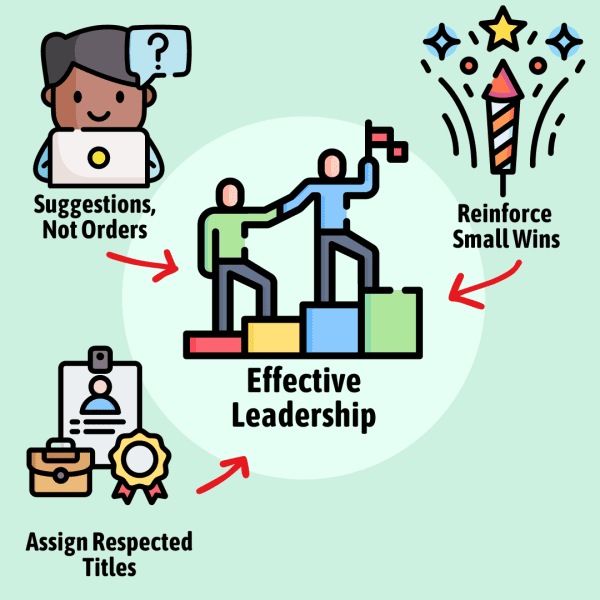
Here are three practical way to be a positive leader:
Celebrate Small Winsng>
Psychologist B.F. Skinner found that positive reinforcement beats punishment almost every time. Even praising slight improvements boosts confidence and keeps momentum going.
One man quit dance lessons after a teacher pointed out everything he did wrong. But a different teacher focused on what he did well—building his confidence instead of crushing it. Result? He kept going and actually improved.
Give Them a Title to Be Proud Ofng>
Assigning a meaningful title can instill a sense of pride and responsibility in an employee. Legendary French General Napoleon gave soldiers honorary titles and medals. At first, critics mocked him for it,
but it built pride, loyalty, and a winning army.
Similarly, a store owner transformed a lazy employee by calling them the “Price Tag Supervisor.” Suddenly, the employee took ownership and pride in the role—and their work improved overnight.
Make It a Gameng>
Friendly competition taps into people’s natural desire to excel and prove their skills. Charles Schwab once boosted productivity at a steel mill by writing the day shift’s output number in chalk on the floor.
The night shift saw the number—and naturally wanted to beat it. That friendly competition led to a big spike in performance.
- Don’t lead using criticism, which tends to kill long-term motivation. Positive reinforcement makes people want to do their best work through praise, encouragement, and ownership.
- Praise progress, even small improvements.
- Give titles, they can make people feel proud of and take ownership of their work.
- Start a friendly game to tap into people’s natural competitive instincts.
What about great businesspeople today? How do they manage their teams?
Bob Iger, who served as Disney’s CEO for over 15 years, also struggled with balancing positive encouragement and critical feedback. He said, “It’s a delicate thing, finding the balance between demanding that your people perform and not instilling a fear of failure in them.”
After decades of leadership experience, Bob Iger create this simple rule: “Don’t start negatively, and don’t start small.” What does that mean? He always began feedback with something positive and he focused on the big picture, not the small details.
🤝 11. Soften Your Feedback: If you want people to actually hear your feedback—and act on it—lead with kindness, not criticism.
When giving feedback or correcting someone, the goal isn’t to prove you’re right—it’s to help them improve without making them feel small.
That’s why Dale Carnegie offers several ways to deliver tough messages with empathy, respect, and tact.
1. Start with sincere praise
No one likes to hear criticism. But if you start by recognizing something positive, it opens people up to receiving feedback. Kind of like how dentists give us pain killers before they start drilling.
In one story, a tenant needed to negotiate their rent. Instead of jumping in with demands, they started by complimenting the landlord on how well they managed the building.
The landlord was stunned—nobody had ever thanked them before. People only came to them with problems and complaints. Just that simple appreciation made them more willing to negotiate. In the end, they were able to get a rent decrease.
2. Point out mistakes indirectly
Direct criticism creates embarrassment. Instead, praise positive behavior—or offer a creative, subtle cue.
Charles Schwab once saw workers smoking beneath a “No Smoking” sign. He didn’t scold them. He handed them cigars and said, “I’d appreciate it if you’d enjoy these outside.” The lesson was received—without anyone losing face.
3. Be sympathetic, not harsh
Whenever we are trying to change someone else’s behavior, it’s best to start with empathy. That means asking: Why are they doing this?
A piano teacher had a student whose long nails made it hard to play. Instead of criticizing her, the teacher understood the girl took pride in her nails.
So the teacher said, “Your nails are beautiful, but trimming them would help you improve.” Because the advice was delivered with empathy and kind words, not judgment, the student didn’t argue. She trimmed her nails happily.
4. Share your own flaws first
If you admit your own mistakes first, it makes others more open to hearing about theirs.
Carnegie’s niece made mistakes while working as his secretary. Instead of scolding her, he said: “When I was your age, I made far worse blunders in business.” That honesty made his feedback easier for her to hear—and more likely to stick.
5. Give suggestions, not orders
Telling people what to do triggers resistance. Instead, why not give them a suggestion to consider?
Instead of saying, “Do this differently.” Try, “Maybe it would work better this way?”
Same message. Totally different reaction.
6. Help others save face
When people mess up, don’t embarrass them. Correct them privately. Remind them that everyone makes mistakes. Show faith in their ability to do better.
Even when someone needed to be demoted, Carnegie advised moving them into a different role with a more important-sounding title to protect their dignity.
- Lead with sincere praise instead of blunt criticism. Rather than focusing on what someone is doing wrong, highlight the behaviors you want to see more of. You can also share your own mistakes first to make your feedback easier to accept.
- Don’t give orders, but gentle suggestions. Correct privately to help them save face—and they’ll respect you more and improve faster. Ask yourself, “Why are they doing that?” to build empathy before offering advice.
😇 12. Assume Good Intentions: See people in a positive light—and they’ll often become friends, not enemies.
Most people aren’t trying to be difficult—they just want to be respected and understood. If you start from a place of trust and treat mistakes like accidents, you’ll avoid escalating small misunderstandings into big conflicts.
Here are a few of Dale Carnegie’s methods to achieve this:
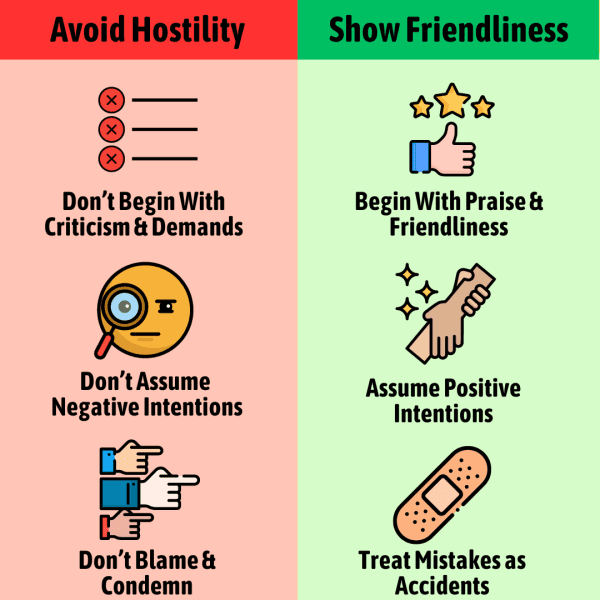
1. Begin confrontations with a friendly vibe
When a conversation could get heated, you can change everything by beginning with a warm greeting and praise.
For example, John D. Rockefeller Jr. once resolved a violent worker strike by expressing pride and honor in speaking with the workers, positioning himself as a friend rather than an adversary. The result? The tension melted away, and real conversations could happen.
2. Appeal to their higher values
People act from a mix of motives—some selfish, some noble. But if you want to influence them, speak to their better side.
When a university asks a billionaire for a donation, they don’t say, “Hey, you want your name on a building, right?” They emphasize giving back to the community, creating a legacy, inspiring future generations—the values the donor wants to believe about themselves.
As J.P. Morgan said: “A person usually has two reasons for doing a thing: one that sounds good, and the real reason.”
Speak to the good reasons.
3. Assume mistakes are just that—mistakes
When someone slips up, don’t assume the worst.
Remember that story about Charles Schwab catching workers smoking inside the factory. He could have gotten angry and started yelling. Instead, he assumed they had simply forgot, not that they were intentionally breaking the rules. And he corrected their mistake without creating resentment, by walking over and giving them the cigars “to smoke outside.”
4. Respect their needs and desires
When Dale Carnegie saw teenagers building fires in a public park, he could’ve shouted at them to stop. After all, they were doing something dangerous. There had been fires spreading recently in that park.
Instead, he started by finding common ground. He understood the teenagers wanted to enjoy their summer around a nice fire. So he told them, “I love building fires too. What are you cooking?” Then, with respect, he asked them to be careful with putting the fire out.
The teenagers listened—because they felt respected, not bossed around.
- Start hard conversations with warm words and praise, not attack. See the situation from their point of view to create understanding.
- Assume positive intentions, even when things go wrong. This makes you talk to people in a way that is less likely to cause conflict and resentment. Appeal to people’s higher reasons for doing anything, not selfish reasons.
- Replace judgment with curiosity. When someone annoys you, don’t react. Pause and ask yourself: Why are they acting that way? Try to understand before responding
- Give one genuine compliment today. Pick someone—coworker, friend, stranger—and tell them something real you appreciate about them. Be specific, not generic.
- Ask someone about their goals. Instead of talking about your ideas, ask someone: “What’s something you’re working on right now?” Then listen.
- Get curious instead of talking about yourself. Ask follow-up questions. Show genuine interest. Make the other person feel like they are the most interesting person in the room.
- Smile at the next person you see. Even if it’s small or awkward—do it. Then notice how they respond.
- Use someone’s name in conversation. Whether it’s in person or in writing, use their name once naturally. People feel recognized when you do.
- Listen without interrupting. The next time someone talks, try this: no advice, no stories, no waiting to talk. Just listen and nod. Let them finish fully.
- Disagree with “It seems to me…” instead of “You’re wrong.” If a disagreement comes up, soften your language. Show humility, and you’ll invite openness instead of resistance.
- Ask, don’t tell. Next time you want someone to do something, ask a guiding question like: “What do you think about trying it this way?”
- Praise one small improvement. Catch someone doing something right—even just a little—and point it out. It reinforces the behavior and boosts motivation.
- Give feedback with empathy. Before offering any criticism, lead with sincere praise. Share your own similar mistake first to soften the message.
- Assume the best. If someone messes up, tell yourself: They probably didn’t mean to. Respond with calm curiosity and speak to their higher values.
Dale Carnegie says the most important principle is that people…
Like to do the talking
Can't take any criticism
Want lots of compliments
Need a feeling of importance
What's the most effective way to influence others?
Point out mistakes directly
Show humility and ask questions
Provide strong logical arguments
Flatter them with compliments
What’s the real reason criticism rarely works?
It's not specific enough
It's usually not fact-based
It triggers defensiveness
People prefer compliments
What is the best way to enter a tough conversation?
Assume they want to rip you off
Begin in a warm, friendly way
Never split the difference
Make your demands clear
Which strategy is most effective for building genuine friendships according to Dale Carnegie?
Providing smart advice
Always giving compliments
Bringing over good snacks
Asking questions and listening















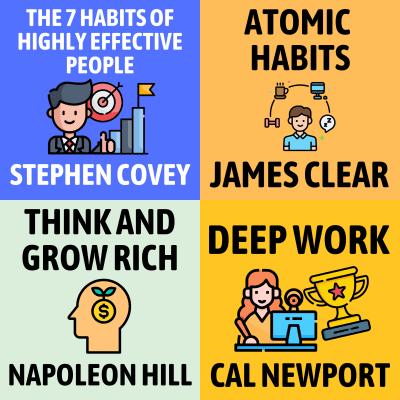

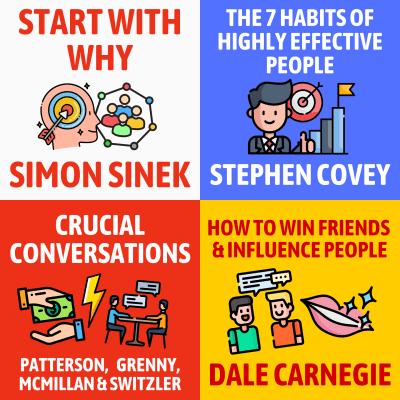





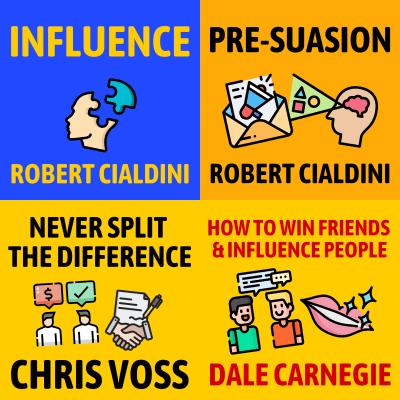
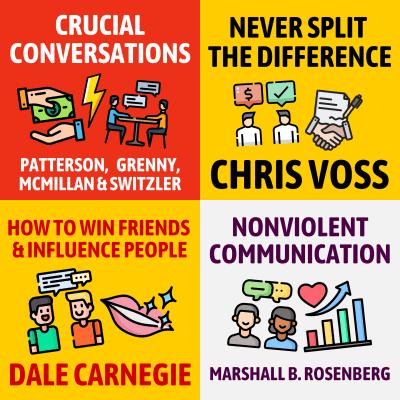














Community Notes